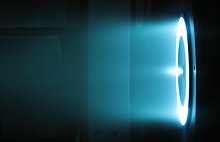
Back دفع مركبة فضائية بالطاقة الكهربائية Arabic Retropropulsión espacial eléctrica Spanish Elektriline rakettmootor Estonian پیشرانه الکتریکی فضاپیما Persian Propulsion électrique (spatial) French הנעה חשמלית בחלל HE Elektromos hajtómű Hungarian Propulsione elettrica per uso spaziale Italian 電気推進 Japanese Elektriskais raķešdzinējs Latvian/Lettish

Spacecraft electric propulsion (or just electric propulsion) is a type of spacecraft propulsion technique that uses electrostatic or electromagnetic fields to accelerate mass to high speed and thus generating thrust to modify the velocity of a spacecraft in orbit.[1] The propulsion system is controlled by power electronics.
Electric thrusters typically use much less propellant than chemical rockets because they have a higher exhaust speed (operate at a higher specific impulse) than chemical rockets.[1] Due to limited electric power the thrust is much weaker compared to chemical rockets, but electric propulsion can provide thrust for a longer time.[2]
Electric propulsion was first demonstrated in the 1960s and is now a mature and widely used technology on spacecraft. American and Russian satellites have used electric propulsion for decades.[3] As of 2019[update], over 500 spacecraft operated throughout the Solar System use electric propulsion for station keeping, orbit raising, or primary propulsion.[4] In the future, the most advanced electric thrusters may be able to impart a delta-v of 100 km/s (62 mi/s), which is enough to take a spacecraft to the outer planets of the Solar System (with nuclear power), but is insufficient for interstellar travel.[1][5] An electric rocket with an external power source (transmissible through laser on the photovoltaic panels) has a theoretical possibility for interstellar flight.[6][7] However, electric propulsion is not suitable for launches from the Earth's surface, as it offers too little thrust.
On a journey to Mars, an electrically powered ship might be able to carry 70% of its initial mass to the destination, while a chemical rocket could carry only a few percent.[8]
- ^ a b c Choueiri, Edgar Y. (2009) New dawn of electric rocket Scientific American 300, 58–65 doi:10.1038/scientificamerican0209-58
- ^ "Electric versus Chemical Propulsion". Electric Spacecraft Propulsion. ESA. Retrieved 17 February 2007.
- ^ "Electric Propulsion Research at Institute of Fundamental Technological Research". 16 August 2011. Archived from the original on 16 August 2011.
- ^ Lev, Dan; Myers, Roger M.; Lemmer, Kristina M.; Kolbeck, Jonathan; Koizumi, Hiroyuki; Polzin, Kurt (June 2019). "The technological and commercial expansion of electric propulsion". Acta Astronautica. 159: 213–227. Bibcode:2019AcAau.159..213L. doi:10.1016/j.actaastro.2019.03.058. S2CID 115682651.
- ^ "Choueiri, Edgar Y. (2009). New dawn of electric rocket".
- ^ "Google Scholar". scholar.google.com.
- ^ Geoffrey A. Landis. Laser-powered Interstellar Probe Archived 22 July 2012 at the Wayback Machine on the Geoffrey A. Landis: Science. papers available on the web
- ^ Boyle, Alan (29 June 2017). "MSNW's plasma thruster just might fire up Congress at hearing on space propulsion". GeekWire. Retrieved 15 August 2021.
© MMXXIII Rich X Search. We shall prevail. All rights reserved. Rich X Search